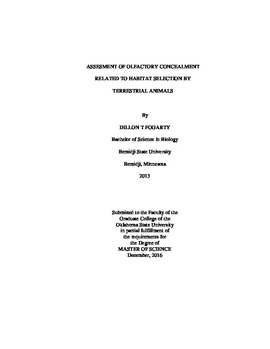| dc.description.abstract | Animals use habitat selection to mitigate adverse effects environmental factors may have on their fitness. For many prey species, predation by olfactory-sensing predators is an environmental factor that has devastating impacts on their fitness. To minimize risk from olfactory-sensing predators, prey should select cover that reduces their odour cues that predators use to find them. The olfactory concealment theory predicts that this can be accomplished through selection of airflow characterized by high turbulence and/or updrafts. However, few studies have investigated airflow patterns as a dimension of cover. Here, I characterized the olfactory landscape, and assessed how olfaction relates to habitat selection and nest success of grassland-nesting birds. Specifically, I measured olfactory concealment and vegetation characteristics (e.g. visual concealment, grass height, etc.) within grassland, shrubland, and forest vegetation types and at nests in grassland vegetation. At a subset of points, I tested whether visual and/or olfactory concealment influenced depredation rates of simulated prey. Additionally, I modeled the relative importance of visual concealment, as well as airflow and weather conditions associated with olfactory concealment to nest survival. I found that turbulence intensity and airflow slope varied by vegetation type, and in grasslands horizontal concealment, vegetation height and vegetation roughness were positively correlated to turbulence intensity. Additionally, in grasslands turbulence intensity was the best predictor of simulated prey depredation. Together, these findings provide the first approximation of an olfactory landscape, which could potentially be used by animals to make space use decisions and in grasslands may be able to decrease rates of predator detection. However, contrary to expectations, grassland-nesting birds did not select nest sites with significantly higher levels of turbulence intensity (p=0.10), but did select more overhead visual concealment. A finding that I suspect reflects a habitat selection strategy to mitigate thermal conditions. Precipitation and humidity were important predictors of nest survival and were positively related. I hypothesize that moisture-related weather conditions indirectly influences nest survival through predation by olfactory-sensing predators. Findings here support those of others that weather can have a large impact on vital rates and that in some cases, habitat selection can potentially mitigate adverse effects of weather. | |
